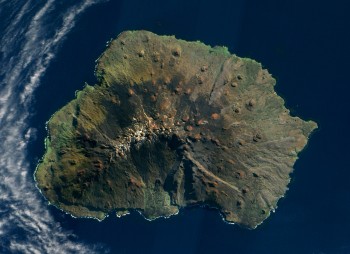The South African Minister of Water and Environmental Affairs, Ms Bomo Edna Molewa, MP, yesterday declared 180 000 km² of the seas surrounding the Prince Edward Islands to be a Marine Protected Area (MPA) (click here). The declaration has come almost seven years after the then Minister of Environmental Affairs Marthinus van Schalkwyk announced his intention to declare an MPA around the two islands of Marion and Prince Edward.


Marion Island (top) and Prince Edward Island on very rare near-cloudless day
Photograph taken by NASA satellite on 05 May 2009
The new MPA’s waters are utilized by the nine species of ACAP-listed albatrosses and Petrels that breed on Marion and Prince Edward Islands, most notably 44% of the global population of the Vulnerable Wandering Albatross Diomedea exulans and 21% of the World’s Endangered Indian Yellow-nosed Albatrosses Thalassarche carteri.

Albatross Valley on Prince Edward Island
Home to the greatest concentration of breeding Wandering Albatrosses in the World
Photograph by Bruce Dyer
“The new Prince Edward Islands MPA, the first South African offshore MPA, will serve to significantly contribute to global initiatives towards protection of offshore and deep ocean areas. The declaration is in line with South Africa’s new “National Protected Areas Expansion Strategy” which seeks to structure the way in which protected areas are declared in order to maximise conservation benefits. The Prince Edward Islands MPA is a significant contribution to the conservation of global biodiversity. The new MPA will also contribute significantly towards South Africa’s national and international commitments to biodiversity protection,” said Minister Molewa.
Minister Molewa also added that, “the new MPA is intended, among other things, to contribute to the protection of unique species, habitats and ecosystem processes. It will also provide scientific reference points that can inform the future management of the area and to be able to understand better the impacts of climate change on the whole Southern Ocean. It will also contribute to integrated and ecologically sustainable management of marine resources of the area.”

The Prince Edward Islands MPA, showing the several zones
The new MPA is comprised of three categories of zones:
$1· A 12-nautical mile sanctuary (no-take) zone surrounding the two islands,
$1· Four restricted zones, in which fishing effort is to be limited, and
$1· A controlled zone, linking the four restricted areas. This zone is to be managed as a low-impact zone that links the four zones spatially.
Satellite-tracking of albatrosses and seals from Marion island was used to inform the selection of the four restricted zones.
The 12-nm sanctuary zone will allow for the preservation of the islands’ near-shore ecosystem and also contribute towards the recovery of the Patagonian Toothfish Dissostichus eleginoides population. Limited utilization of the toothfish resource by South African vessels will take place outside the sanctuary area.
Click here to read the response of WWF South Africa to the MPA being declared.
Selected References:
Lombard, A.T., Reyers, B., Schonegevel, L.Y., Cooper, J., Smith-Adao, L.B., Nel, D.C., Froneman, P.W., Ansorge, I.J., Bester, M.N., Tosch, C.A., Strauss, T., Akkers, T., Gon. O., Leslie, R.W. & Chown, S.L. 2007. Conserving pattern and process in the Southern Ocean: designing a Marine Protected Area for the PrinceEdwardIslands. Antarctic Science 19: 39-54.
Nel, D. & Omardien, A. (Eds). 2008. Nel, D. & Omardien, A. (Eds). 2008. Towards the development of a Marine Protected Area at the Prince Edward Islands. WWF South Africa Report Series 2008/Marine/001. 180 pp.
John Cooper, ACAP Information Officer, 10 April 2013

 English
English  Français
Français  Español
Español